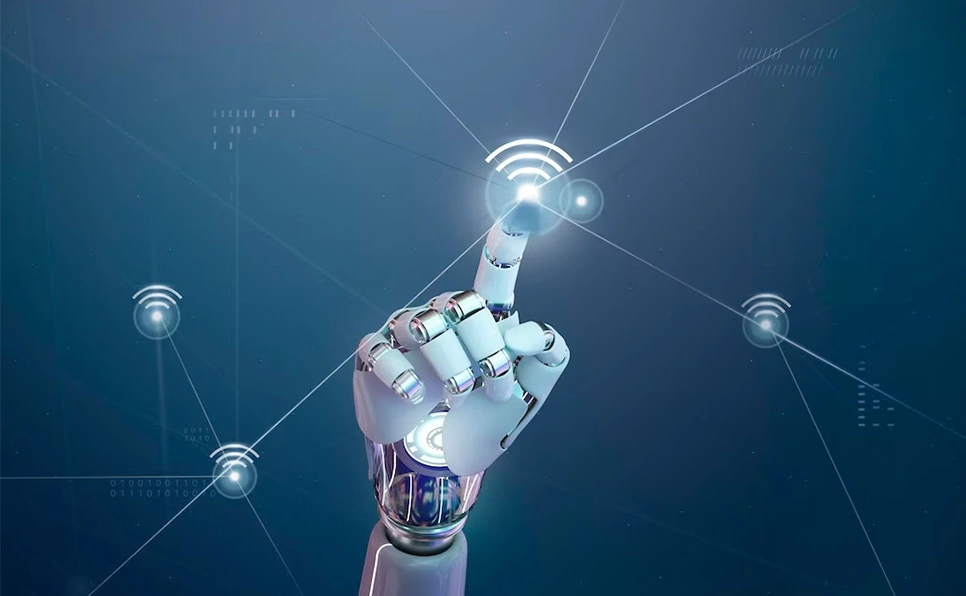AI technology trends are continuously changing. Staying current on the latest advances is critical to comprehend their potential impacts on various businesses and society.
This blog illustrates the top 10 AI technology developments to watch in 2023, with examples of AI applications in fields like autonomous driving, cybersecurity, and healthcare.
Trend 1: AI-powered automation
AI-powered automation transforms industries and businesses by automating routine tasks, increasing efficiency, reducing errors, and increasing productivity. Examples include using AI-powered robots in manufacturing to perform repetitive tasks, healthcare using AI-powered chatbots to answer patient questions, and finance using AI for detecting fraud. AI is also being used to provide personalized shopping experiences with AI-powered recommendations in retail, reducing costs and increasing efficiency.
Trend 2: Natural language processing (NLP)
Natural Language Processing (NLP) is a part of artificial intelligence that focuses on the synergy between computers and humans using natural language. It enables computers to understand, interpret, and generate human language, helping them to process large amounts of text data, derive insights, and automate tasks.
NLP can be applied to many areas, such as healthcare, customer service, marketing, and finance. For example, in healthcare, NLP can analyze electronic medical records to identify patterns that can help diagnose and treat disease. Customer service can use NLP to create chatbots that answer customer questions and provide 24/7 support.
Trend 3: AI in healthcare
AI is increasingly being used in healthcare to improve patient care and outcomes. AI-powered algorithms analyze medical images, detect anomalies, and help doctors make more accurate diagnoses. It also helps speed the drug discovery process, create personalized treatment plans, manage chronic diseases, and predict which patients are at risk for certain diseases and complications.
In addition, AI-powered virtual assistants can provide patients with information about their health status and treatment plans, answer frequently asked questions, and remind patients of appointments and medications. It is also being incorporated by many apps that offer the delivery of medicines.
Trend 4: AI-powered cybersecurity
AI is being used to improve cybersecurity by automating threat detection and response, reducing the risk of cyberattacks, and increasing the speed and accuracy of incident response. For example, AI-powered intrusion detection systems can automatically identify and respond to threats in real-time, minimizing the risk of data breaches and various other cyber attacks. AI can also analyze network traffic and identify potential vulnerabilities or security gaps. In addition, AI-powered security tools can monitor user behavior and detect unusual activity, such as unauthorized access attempts or data exfiltration.
Trend 5: Autonomous vehicles
We have all heard about Tesla, haven’t we? Autonomous vehicles, or self-driving cars like Tesla, have been a hot topic of discussion in the current times. (Especially after Musk’s popularity with Tesla and his Tweets!) AI is a critical component of autonomous vehicle technology. Self-driving cars use a range of sensors, cameras, and other devices to collect data about their environment, including road conditions, traffic patterns, and other vehicles. This data is then processed by AI algorithms that analyze and interpret it to make decisions about steering, accelerating, and braking. AI is also used to predict and respond to potential hazards, such as pedestrians or vehicles on the road.
Trend 6: AI-powered personalization
AI is used to personalize user experiences by analyzing user data and behavior to tailor recommendations and content to their preferences. This technology has become increasingly prevalent in e-commerce, social media, and entertainment platforms, where it is used to enhance user engagement and satisfaction. The best example is the personalized recommendation you get on Netflix or Spotify. These platforms use AI algorithms to analyze the user’s viewing and listening history and provide customized recommendations for movies, TV shows, and music based on their tastes.
Trend 7: AI-powered predictive analytics
AI-powered predictive analytics is used to identify patterns and trends in large data sets, enabling organizations to make more precise predictions about future events and behaviors. Potential benefits of this technology include improved decision-making, increased efficiency, and reduced costs. AI-powered predictive analytics can be applied in various industries, from finance and healthcare to marketing and manufacturing. For instance, banks can use predictive analytics to identify potential fraud and credit risk.
Trend 8: AI and the Internet of Things (IoT)
IoT and AI are used to build intelligent, networked systems to gather and analyze massive volumes of data in real time. This data can be analyzed by AI algorithms to learn about user behavior and preferences, which can then be used to autonomously change the environment to meet those demands. One example of AI with IoT applications is the smart homes, where sensors and gadgets are linked to the internet and may be controlled by voice commands or mobile apps such as Alexa.
Trend 9: Quantum computing and AI
Combining quantum computing and AI has a wide range of potential advantages since quantum computing can speed up and improve the efficiency of AI algorithms as they handle massive volumes of data. This could result in innovations in industries that depend on complicated data sets and calculations, such as medicine discovery, climate modeling, and financial analysis. For instance, by mimicking the behavior of molecules, quantum computing could assist researchers in developing novel pharmaceuticals by helping them identify viable therapies more quickly.
Trend 10: Explainable AI (XAI)
As AI algorithms become more complicated and pervasive, explainable AI (XAI) is becoming more and more significant. XAI is a term used to describe AI systems that can explain their actions and reasoning in detail, increasing their transparency and dependability. Applications like healthcare and finance, where the effects of AI decision-making can be enormous, are where XAI is particularly crucial. For instance, XAI can explain how a medical diagnosis was achieved, assisting medical professionals and patients in comprehending and believe the findings.
So, these were the top 10 AI technology trends that are trending in 2023. Are you ready to incorporate these trends in your marketing strategies?




